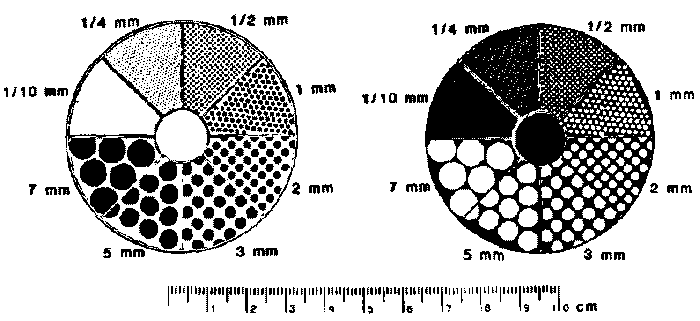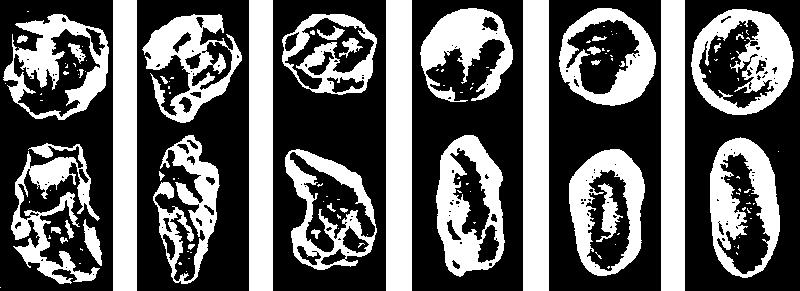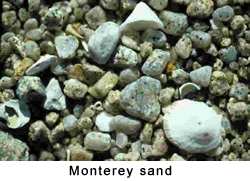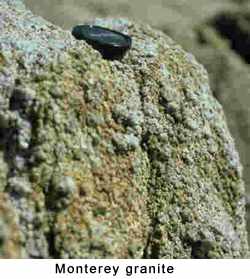BACKGROUND:
Sedimentologists (geologists that work with sedimentary rocks),
understand the significance of sand grains in rocks. The size, shape, and
roundness help to explain the sandstone’s "life history."
This lab emphasizes two points. First, sand composition reflects the sand’s
source. Second, the roundness of individual sand particles reflects how far
the sand traveled and for how long. Sand is usually created when water
and/or wind break off small pieces of pre-existing rock. If the particle is
"newly" broken off, it tends to have an angular look, but if the
particle has traveled by water or wind for a long time it becomes rounded.
The river's water carries the rocks along the bottom of the river bed.
The pebbles are eroded by abrasion. The longer a pebble stays in the river
bed, the more rounded it will become. The more angular a pebble the shorter
the period of time it has been moving.
Since sand comes from a "Mother" or source
rock, it is possible
to determine what type of rock produced the "baby rocks." The
composition and general color of both the "baby" and
"mother" rock are often very similar. There are five possible
source materials for the sand in this lab. Granite is a plutonic igneous
rock. It occurs in varying shades of light and dark colors depending on the
specimen’s mineral composition. Serpentinite is a metamorphic rock that is
smooth, green, and scaly. It is the state rock of California. Chert is a
sedimentary rock that forms from the shells of microscopic marine life in
deep ocean environments. It is very hard, and comes in many colors. Quartz
is found in many rocks including granite and chert, and is the main
constituent of most sand. Most quartz crystals are clear or white in color.
Basalt is a dark, fine -grained igneous rock.
PROCEDURE:
- Before lab, prepare sand samples for each student group, using the
Rock Cycle - Rocks (4B) kit. Set up microscopes for each group. If you
are not familiar with the sand identification charts, you may wish to
experiment before the lab. You may want to sprinkle some sand on a
piece of tape, so it is easier to view under the microscope. Sand
in petri dishes can also aid in observation,
- Instruct the students to use the size component of the Sand Chart
(shown below) to determine the shape of the sand particles. If you have
microscopes, use tape to hold a few particles in place under the
objective. If you have the Swift GH microscope, you can keep the sand in
the bag and have the students observe the sand through the bags. Have
the students illustrate their observations. In most cases, the students
will see a range of sizes. Size generally indicates how long a particle
has been eroding and moving. The longer time, the smaller the particle
will be.

- Instruct the students to compare the particles in their sand samples
with the diagram below. In the diagram below, the most rounded grains
are on the right, the most angular are on the left. Students find this
difficult because they have to make a decision based on their
observation. Again, microscopes are helpful. The rounder a particle, the
longer it has been moving

Tell the students to try and identify the source rock for each sand
sample. Emphasize that rocks contain many clues about their origins.
Tell the students that they can interpret the history of rocks, using
their powers of observation. Show examples of "mother" or
source rocks to the students. Describe the origin of each source
material to the students. Be sure to point out that quartz is a mineral
and not a rock. Each sand sample will resemble the mother rock because
the sand has the same mineral composition. Have samples of granite,
chert, serpentinite, and basalt on display to aid the students in their
description of the sand samples.
 CLEONE, Mendocino County, California -.25-0.5mm; well sorted;
subangular - subrounded. Contains quartz, feldspar, and dark lithic
fragments. The dark color is due to about 20% of lithic fragments. Also
may contain pieces of shell material. Type of rock from drainage area is
greywacke. CLEONE, Mendocino County, California -.25-0.5mm; well sorted;
subangular - subrounded. Contains quartz, feldspar, and dark lithic
fragments. The dark color is due to about 20% of lithic fragments. Also
may contain pieces of shell material. Type of rock from drainage area is
greywacke.
MONTEREY, California - 025 -7mm; very poorly sorted;
subangular.
Contains quartz, feldspar and pieces of granitic rock. The Mother rock
is a granite, but unlike Montara  Beach sand, Monterey has not been
chemically weathered. Abrasion of large boulders of granite along the
coast have mechanically broken this sand. Beach sand, Monterey has not been
chemically weathered. Abrasion of large boulders of granite along the
coast have mechanically broken this sand.
OAKWOOD HEIGHTS BEACH,
Staten Island, New York -0.25 -1mm; well sorted; angular - rounded.
Contains quartz, feldspar and magnetite. This sand is eroding from a
sandstone that probably had a granitic origin, which has more
pinkish/orange feldspars in it, then the California counterpart.
SAN FRANCISCO, California -0.1 -0.5mm; well sorted; subangular
to subrounded and crystals. Contains quartz, mica, feldspar and
magnetite (magnetic) Derived from sandstones exposed along cliffs south
of Ocean Beach.
RODEO BEACH, Marin County, California -0.1 -7mm; poorly
sorted; angular - rounded. Contains chert, serpentinite, quartz, basalt,
magnetite. This beach is in a cove behind the Golden Gate Bridge, where
very high energy waves erode the rocks exposed along this coast. The
source rocks include chert, serpentinite, and basalt.
|